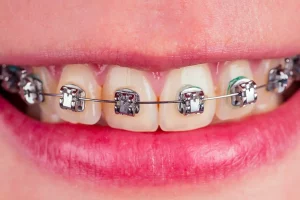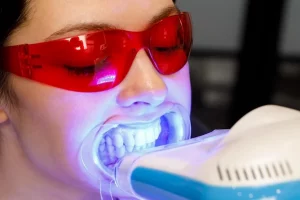Dental scaling and polishing are essential components of oral hygiene, but they serve distinct purposes. Understanding the difference between the two procedures is crucial for maintaining optimal dental health. In this blog, we’ll explore the processes involved in each procedure, the specific benefits they offer, and the distinction between each other to leave you with a dazzling, healthy smile. By understanding these procedures, you can make informed decisions about your dental care and achieve a bright and healthy smile.
Dental Scaling:
Dental scaling, often known as prophylaxis or dental cleaning, is a preventative dental procedure that involves removing plaque and tartar from the teeth and gums. A dental hygienist or dentist does it and uses specialized instruments to clean and polish tooth surfaces, thereby reducing cavities and gum disease. Regular dental cleanings are essential for maintaining excellent oral health and avoiding more serious dental problems in the future.

Benefits of Dental Scaling
The benefits of dental scaling include:
1. Prevention of Cavities:
Plaque, a sticky film of bacteria that can cause cavities, is removed during dental scalings. Regular dental cleaning helps avoid tooth enamel decay and the formation of cavities.
2. Gum Disease Prevention:
Cleaning helps to remove tartar, which, if ignored, can lead to gum disease. This preventative approach lowers the risk of gingivitis and other severe periodontal problems.
3. Fresh Breathe:
Plaque and tartar removal also help to improve breath quality. Dental cleanings help to eradicate the microorganisms that cause bad breath, improving overall dental hygiene.
4. Early Detection of Oral Issues:
Regular cleanings enable dental professionals to identify and treat oral health problems early on. This early action may prevent the spread of issues and eliminate the need for more extensive dental treatments.
5. Enhanced overall health:
Regular mouth cleanings have been linked to better overall health. There is evidence connecting oral health to illnesses such as heart disease and diabetes, making dental cleanings an essential aspect of preventative treatment.
Dental Polishing
Dental polishing is a cosmetic dental operation that comes after dental scaling. It entails utilizing a rotating rubber cup or prophy brush and polishing paste to smooth tooth surfaces and remove tiny stains, thus improving the overall appearance of the teeth. While dental polishing has no direct impact on oral health, it does help to a cleaner, brighter smile.

Benefits of Dental Polishing
1. Improved aesthetic
Dental polishing improves the appearance of teeth by removing surface stains, creating a cleaner and brighter smile.
2. Smoothing Tooth Surfaces
This procedure smooths tooth surfaces, minimizing opportunities for plaque and stains to collect and contributing to improved oral hygiene.
3. Confidence
A polished smile can increase self-esteem and confidence, resulting in a more favorable self-image and social relationships.
4. Stain Removal
Dental polishing successfully removes extrinsic stains caused by coffee, tea, and smoking, returning teeth to their original color.
5. Dental Cleaning
When paired with dental cleaning, polishing offers a complete solution for both oral health and cosmetic appeal.
What are the procedures involving scaling and polishing?
Scaling and polishing are standard dental procedures that help to maintain good oral health and a dazzling smile. The following operations are performed by dental scaling and polishing treatment.
Process for Dental Scaling
1. Examination: The dentist or dental hygienist evaluates the patient’s overall oral health, looking for symptoms of problems such as cavities or gum disease.
2. Scalability: Plaque and tartar are removed from tooth surfaces using specialized tools, which are especially useful in hard-to-reach places.
3. Polish: After scaling, the teeth are polished with a rotating rubber cup or prophy brush containing a polishing paste. This smoothes tooth surfaces and removes small stains.
4. Flossing: Flossing can be used to guarantee complete cleaning between teeth and along the gumline.
5. Fluoride treatment (optional): Some cleanings may include the application of fluoride to build tooth enamel and prevent cavities.
The dental expert advises on oral care habits, such as correct brushing and flossing techniques, and may recommend additional treatments or follow-up consultations if necessary.
Process for Dental Polishing
Preparation: Following teeth cleaning, the dental professional prepares for polishing by selecting proper instruments and polishing paste.
Polishing Paste: A revolving rubber cup or prophy brush is loaded with polishing paste and used to apply it to tooth surfaces.
Polishing: The revolving tool polishes the tooth surfaces, eliminating mistakes and minor stains.
Rinse and evaluate: The dentist rinses the mouth to remove any remaining paste and then analyzes the polishing results.
Final assessment: The polished teeth are evaluated for enhanced aesthetics, and the patient may be given aftercare instructions to keep the results.
Difference Between Dental Scaling and Dental Polishing
Here’s a table that shows the main differences between dental scaling and dental polishing:
| Aspect | Dental Scaling | Dental Polishing |
| Purpose | Preventive measures to remove plaque and tartar. | A cosmetic procedure that improves the appearance of teeth. |
| Benefits | It prevents cavities, gum disease, and bad breath. | Improves smile appearance and removes extrinsic stains. |
| Procedure | Plaque and tartar are removed from the tooth surfaces. | Smoothing the tooth surfaces and removing minor stains. |
| Focus | Eliminating germs and preventing oral illness. | It improves the appearance and removes surface stains. |
| Clinical Focus | Emphasis on oral health and disease prevention. | Emphasis on cosmetic improvements and smile aesthetics |
| Tools Used | Scaling and cleaning tools are specialized. | A rotating rubber cup or prophy brush is used for polishing. |
| Frequency | It is typically suggested every 6–12 months for the preservation of oral health. | Typically conducted as part of routine dental cleaning, the frequency may vary depending on individual needs and preferences. |
| Performed by | Dental hygienist or dentist | Dental hygienist or dentist |
Conclusion
To summarize, recognizing the distinction between dental scaling and polishing is essential for maintaining good oral health and creating a beautiful smile. Qualified experts conduct dental cleanings and focus on preventive treatment by removing plaque and tartar, which reduces the risk of cavities and gum disease. Dental polishing, on the other hand, is commonly done after cleaning to improve the cosmetic appeal of teeth by smoothing their surfaces and removing stains. Together, the procedures available at Oris Dental Center give a complete approach to both health and beauty, ensuring that your smile remains healthy, vibrant, and confident.





